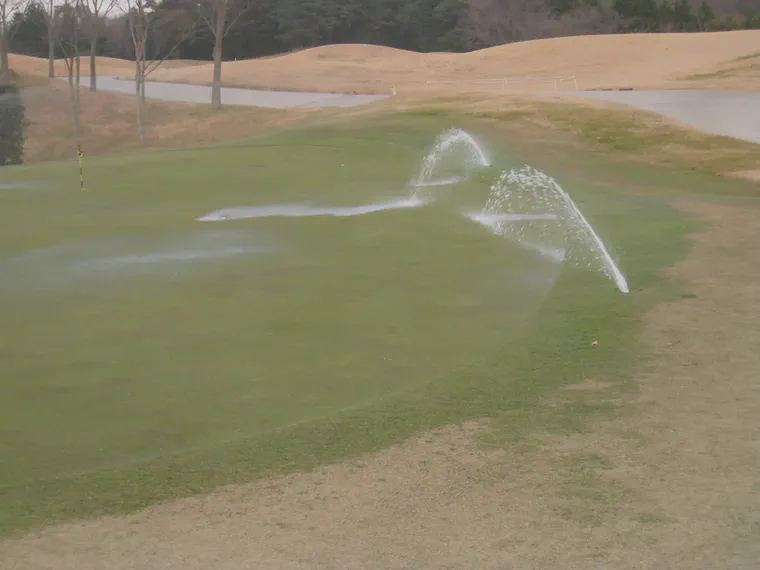Soil and water management: 3 primary problems, with solutions
Here are three primary things to be concerned with when considering soil and water: salinity, the sodium hazard, and nutrient deficiencies. I explain solutions for each of these problems in this post, which was originally a handout for a seminar I gave on this topic some years ago.1

Salinity
Warm-season grasses such as bermudagrass (Cynodon spp.), seashore paspalum (Paspalum vaginatum), and zoysiagrass (Zoysia spp.) are relatively tolerant of salt in applied irrigation water. However, if the salt applied through the irrigation water accumulates in the soil, the grass can fail.
The amount of salt in a solution is reported in two ways - as the electrolytic conductivity (EC, in units of decisiemens per meter, dS/m), or as the total dissolved solids (TDS, in units of parts per million, ppm). There is an empirical relationship between these two units. Each unit increase in EC of 1 dS/m will be roughly equivalent to an increase of about 640 ppm in TDS units.
The salinity of two different solutions must be evaluated. First, one needs to know the salinity of the irrigation water. This is represented as EC
There is no cutoff point for EC
That is, we can expect those grasses to tolerate levels of soil salinity (EC
There is a two step process to calculate the amount of water that must be applied in order to manage the EC
where …
LR is leaching requirement, EC
Second, relate that leaching requirement (LR) to the grass’s use of water (ET), and calculate the water requirement, using this equation:
For more information, see Leaching for Maintenance from the University of Arizona.
As an example, let’s consider an irrigation water with a TDS of 1280 ppm (EC
Calculating the LR using the first equation, we get 0.05. Then, using the second equation, we can calculate the water requirement as 5.3 mm. That is, when the ET is 5 mm, using an irrigation water with EC
Leaching of salts is much easier in sand rootzones.
Sodium hazard
When soils contain too much sodium, the soil structure can be destroyed through the deflocculation of clay particles. This is not a problem on sand rootzones, but it is a concern on soils containing clay. Soils with more than 15% of the cation exchange sites occupied by sodium (exchangeable sodium percentage, or ESP) are termed sodic soils. These soils may exhibit hardness, poor water infiltration, and bare areas free of plants.
The solution to this problem is through the addition of calcium, usually in the form of gypsum (calcium sulfate dihydrate,
To calculate how much gypsum must be applied, one must consider how much sodium is on the exchange sites, and how much must be replaced by calcium. Let’s imagine a situation where the cation exchange capacity (CEC) of a soil is 100 mmol
And let’s imagine that the ESP of this soil is 15%, which is undesirably high. That is, sodium occupies 15% of the soil’s cation exchange sites, or 15 mmol
First, we calculate that changing the ESP from 15% to 5% in a soil with CEC of 100 mmol
Calcium sulfate dihydrate (
Let’s say we want to modify the soil to a depth of 15 cm, and let the soil have a bulk density of 1.5 g/cc. That amount of soil, in an area of 1 square meter, will have a mass of 225 kg. We would need to apply 860 mg of gypsum to each 1 kg, so for the 225 kg in 1 square meter, 194 g of gypsum are required.
Nutrient deficiencies
Nutrient deficiencies can be avoided by applying just what the grass requires. This article from the January 2014 issue of GCM explains how soil tests can be used to ensure the grass is supplied with all the required nutrients.
If soil testing is not done, nutrient deficiencies can be avoided by applying the amount of nutrients that are used by the grass. For a look at how to estimate these, see Nutrient Requirements of Tropical Turfgrass.
Adding what the grass uses, without considering the soil nutrient levels, will invariably result in overapplication of some nutrients.
Additional reading
For irrigation water quality, a concise guide is Harivandi’s Interpreting Irrigation Water Test Results.
A more detailed guide is Water Quality for Agriculture by Ayers and Westcot.
Nitrogen requirements can be estimated by growth potential. This guide explains how, and the PACE Turf Climate Appraisal Form works through the calculations for your location.
I gave a presentation entitled Soil and Water Management: 3 problems, 3 solutions on 10 March 2014 at the Sustainable Turfgrass Management in Asia conference in Pattaya, Thailand. I’ve had this handout up on a sub-domain of the ATC website but I refer to it occasionally and wanted to put this onto the main site. ↩︎